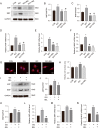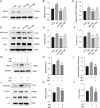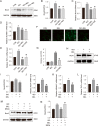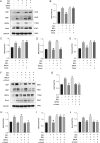Bellidifolin ameliorates isoprenaline-induced cardiac hypertrophy by the Nox4/ROS signalling pathway through inhibiting BRD4
- PMID: 37528096
- PMCID: PMC10394041
- DOI: 10.1038/s41420-023-01563-2
Bellidifolin ameliorates isoprenaline-induced cardiac hypertrophy by the Nox4/ROS signalling pathway through inhibiting BRD4
Abstract
To date, there is no effective therapy for pathological cardiac hypertrophy, which can ultimately lead to heart failure. Bellidifolin (BEL) is an active xanthone component of Gentianella acuta (G. acuta) with a protective function for the heart. However, the role and mechanism of BEL action in cardiac hypertrophy remain unknown. In this study, the mouse model of cardiac hypertrophy was established by isoprenaline (ISO) induction with or without BEL treatment. The results showed that BEL alleviated cardiac dysfunction and pathological changes induced by ISO in the mice. The expression of cardiac hypertrophy marker genes, including ANP, BNP, and β-MHC, were inhibited by BEL both in mice and in H9C2 cells. Furthermore, BEL repressed the epigenetic regulator bromodomain-containing protein 4 (BRD4) to reduce the ISO-induced acetylation of H3K122 and phosphorylation of RNA Pol II. The Nox4/ROS/ADAM17 signalling pathway was also inhibited by BEL in a BRD4 dependent manner. Thus, BEL alleviated cardiac hypertrophy and cardiac dysfunction via the BRD4/Nox4/ROS axes during ISO-induced cardiac hypertrophy. These findings clarify the function and molecular mechanism of BEL action in the therapeutic intervention of cardiac hypertrophy.
© 2023. The Author(s).
Conflict of interest statement
The authors declare no competing interests.
Figures








Similar articles
-
Bellidifolin Ameliorates Isoprenaline-Induced Myocardial Fibrosis by Regulating TGF-β1/Smads and p38 Signaling and Preventing NR4A1 Cytoplasmic Localization.Front Pharmacol. 2021 Apr 30;12:644886. doi: 10.3389/fphar.2021.644886. eCollection 2021. Front Pharmacol. 2021. PMID: 33995055 Free PMC article.
-
The poly(ADP-ribosyl)ation of BRD4 mediated by PARP1 promoted pathological cardiac hypertrophy.Acta Pharm Sin B. 2021 May;11(5):1286-1299. doi: 10.1016/j.apsb.2020.12.012. Epub 2020 Dec 14. Acta Pharm Sin B. 2021. PMID: 34094834 Free PMC article.
-
BRD4 blockage alleviates pathological cardiac hypertrophy through the suppression of fibrosis and inflammation via reducing ROS generation.Biomed Pharmacother. 2020 Jan;121:109368. doi: 10.1016/j.biopha.2019.109368. Epub 2019 Nov 25. Biomed Pharmacother. 2020. PMID: 31707348
-
Bellidifolin from Gentianella acuta (Michx.) Hulten protects H9c2 cells from hydrogen peroxide-induced injury via the PI3K-Akt signal pathway.Toxicol Rep. 2022 Aug 17;9:1655-1665. doi: 10.1016/j.toxrep.2022.08.006. eCollection 2022. Toxicol Rep. 2022. PMID: 36518482 Free PMC article.
-
Bellidifolin Inhibits Proliferation of A549 Cells by Regulating STAT3/COX-2 Expression and Protein Activity.J Oncol. 2020 Nov 21;2020:1723791. doi: 10.1155/2020/1723791. eCollection 2020. J Oncol. 2020. PMID: 33299414 Free PMC article. Review.
Cited by
-
BRD4: an effective target for organ fibrosis.Biomark Res. 2024 Aug 30;12(1):92. doi: 10.1186/s40364-024-00641-6. Biomark Res. 2024. PMID: 39215370 Free PMC article. Review.
-
The mechanism of TGF-β mediating BRD4/STAT3 signaling pathway to promote fibroblast proliferation and thus promote keloid progression.Heliyon. 2024 Sep 21;10(19):e38188. doi: 10.1016/j.heliyon.2024.e38188. eCollection 2024 Oct 15. Heliyon. 2024. PMID: 39391472 Free PMC article.
-
The total xanthones extracted from Gentianella acuta alleviates HFpEF by activating the IRE1α/Xbp1s pathway.J Cell Mol Med. 2024 Jun;28(11):e18466. doi: 10.1111/jcmm.18466. J Cell Mol Med. 2024. PMID: 38847482 Free PMC article.
References
LinkOut - more resources
Full Text Sources
Research Materials
Miscellaneous

